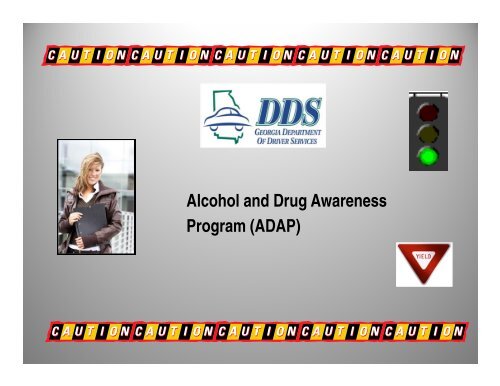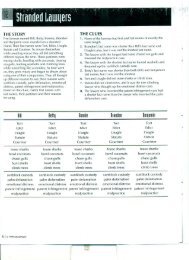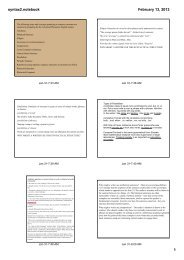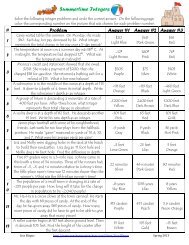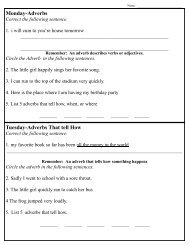Chapter 1 - Norcross High School
Chapter 1 - Norcross High School
Chapter 1 - Norcross High School
Create successful ePaper yourself
Turn your PDF publications into a flip-book with our unique Google optimized e-Paper software.
Alcohol and Drug Awareness<br />
Program (ADAP)
STATE OF GEORGIA<br />
Office of the Governor<br />
ATLANTA 30334-0900<br />
Dear Friends,<br />
The Alcohol and Drug Awareness Program is<br />
one of several important measures passed by<br />
the General Assembly to address the tragic<br />
problems caused by the use of alcohol and<br />
other drugs on our roads and highways.<br />
Anyone under the age of 18 must complete<br />
and pass the alcohol and drug course before<br />
obtaining a license to drive.<br />
Each year, about one‐third of the traffic<br />
deaths on Georgia roads involve a driver<br />
under the influence of alcohol or drugs or a<br />
combination of both. The Department of<br />
Driver Services and the Department of<br />
Education developed this manual to make you<br />
more aware of the problems and the<br />
consequences of driving under the influence<br />
and of riding with other drivers who are<br />
under the influence. It will also assist you in<br />
becoming a more responsible driver.<br />
As your Governor and someone who wants<br />
the best for each of you, I encourage you to<br />
make a promise to yourself and Georgia by<br />
obeying the state’s highway safety laws; your<br />
lives, your families’ lives, and other drivers’<br />
lives depend on it. Make Georgia proud.<br />
Sincerely,
O.C.G.A. §40‐5‐22(a) requires that any person under 18 years of<br />
age complete the Alcohol and Drug Awareness Program (ADAP)<br />
in order to obtain a Georgia driver’s license.<br />
<strong>Chapter</strong> 1<br />
TADRA<br />
<strong>Chapter</strong> 2<br />
Traffic Laws and Safe Driving<br />
<strong>Chapter</strong> 3<br />
Alcohol and Drug Awareness<br />
<strong>Chapter</strong> 4<br />
Summary and Discussion
<strong>Chapter</strong> 1<br />
TADRA
<strong>Chapter</strong> 1<br />
TADRA<br />
• TADRA is an acronym for Georgia’s Teenage and Adult Driver<br />
Responsibility Act.<br />
• Motor vehicle crashes are the leading cause of death for U.S.<br />
teens, accounting for more than one in three deaths in this<br />
age group.
<strong>Chapter</strong> 1<br />
TADRA<br />
TADRA is a Graduated Driver’s Licensing process for newly licensed drivers<br />
15 to 18 years of age. TADRA also contains important provisions specifically<br />
related to driving under the influence (DUI) prevention and enforcement<br />
and school conduct and attendance requirements.<br />
Following enactment of TADRA<br />
Fatal crash rate (16 years of age)<br />
36.8% decline<br />
Speed related crashes (16 years of age)<br />
50 % decline<br />
Alcohol related crashes (16 years of age)<br />
62% decline
Georgia’s Graduated Driver’s Licensing Process<br />
<strong>Chapter</strong> 1<br />
TADRA
A Georgia Instructional Permit (Class CP) is granted to persons at least 15 years<br />
of age upon passing a written examination.<br />
Once issued an Instructional Permit (Class CP), you may operate any Class C<br />
vehicle:<br />
When accompanied by a person at least 21 years of age who is licensed to<br />
drive a Class C vehicle.<br />
Who is fit and capable of exercising control over the vehicle.<br />
Who is occupying a seat beside the driver.<br />
<strong>Chapter</strong> 1<br />
TADRA
Georgia’s Graduated Driver’s Licensing (GDL) Process<br />
STEP TWO: The Provisional License (Class D)<br />
Teens that do not complete an<br />
approved driver training course<br />
are not eligible to obtain a<br />
Provisional License (Class D) until<br />
17 years of age.<br />
<strong>Chapter</strong> 1<br />
TADRA<br />
• A Georgia Provisional License (Class D)<br />
is granted to persons 16 to 18 years of<br />
age.<br />
• Must have held an Instructional<br />
Permit (Class CP) for 12 months and<br />
one day.<br />
• No major traffic violations that<br />
resulted in the mandatory suspension<br />
of their permit.<br />
• Completed ADAP.<br />
• Passed a behind‐the‐wheel skills’ test.
• Class D holders may not drive between<br />
the hours of 12:00 midnight and 6:00<br />
a.m., without exception.<br />
• During the first 6 months following<br />
issuance, only the immediate family<br />
members ride in the vehicle being driven<br />
by the Class D holder.<br />
<strong>Chapter</strong> 1<br />
TADRA<br />
• During the second 6 months following<br />
issuance, only 1 passenger under 21<br />
years of age who is not an immediate<br />
family member may ride in the vehicle<br />
being driven by the Class D holder.<br />
• After the first and second 6‐month<br />
periods, only 3 passengers under 21<br />
years of age who are not immediate<br />
family members may ride in the vehicle<br />
being driven by the Class D holder.
Georgia’s Graduated Driver’s Licensing (GDL) Process<br />
STEP THREE: The Class C License<br />
<strong>Chapter</strong> 1<br />
TADRA<br />
Provisional License (Class D) holders may apply for a Class C Georgia driver’s<br />
license upon reaching 18 years of age; provided, however, they have held a<br />
valid Provisional License (Class D) for one year and one day without having<br />
been convicted of any of the following major traffic violations during the 12<br />
months preceding application:<br />
Driving under the<br />
influence (DUI)<br />
Using a motor vehicle to<br />
flee or attempt to elude a<br />
police officer<br />
Racing on highways or<br />
streets<br />
Reckless driving<br />
Hit and run or leaving the<br />
scene of an accident<br />
Any violation that resulted<br />
in the assessment of 4 or<br />
more points against their<br />
driver's license
TADRA Suspensions (non‐DUI)<br />
<strong>Chapter</strong> 1<br />
TADRA<br />
The State of Georgia applies strict penalties to teens who fail to<br />
obey the laws regarding the operation of a motor vehicle.<br />
The driver’s license of any person under 21 years of age<br />
convicted of any of the following offenses shall be suspended<br />
for a period of 6 months for a first conviction, or for a period of<br />
12 months for a second or subsequent suspension:
Hit and run or leaving the scene of an<br />
accident<br />
Racing on highways or streets<br />
Reckless driving<br />
Aggressive driving<br />
Purchasing or attempting to purchase an<br />
alcoholic beverage<br />
Using a motor vehicle to flee or attempt to<br />
elude a police officer<br />
<strong>Chapter</strong> 1<br />
TADRA
<strong>Chapter</strong> 1<br />
TADRA<br />
Underage possession of alcohol while<br />
operating a motor vehicle<br />
Misrepresenting age for the purpose of<br />
illegally obtaining an alcoholic beverage<br />
Misrepresenting identity or using false<br />
identification for the purpose of<br />
purchasing or obtaining an alcoholic<br />
beverage<br />
Any other offense for which 4 or more<br />
points are assessed against the driver’s<br />
license<br />
The accumulation of 4 or more points<br />
against the driver’s license in any 12‐<br />
month period while under 18 years of<br />
age
TADRA Suspensions (DUI)<br />
<strong>Chapter</strong> 1<br />
TADRA<br />
In Georgia, persons under 21 years of age are presumed to be<br />
DUI if they are operating a motor vehicle and their blood<br />
alcohol concentration (BAC) is .02 or greater.
TADRA Suspensions (DUI)<br />
First Suspension<br />
If your BAC was .02 or greater but less than .08, your license<br />
will be suspended for a minimum period of 6 months.<br />
If your BAC was .08 or greater or you refused implied<br />
consent testing, your license will be suspended for a<br />
minimum period of 12 months.<br />
<strong>Chapter</strong> 1<br />
TADRA
TADRA Suspensions (DUI)<br />
<strong>Chapter</strong> 1<br />
TADRA<br />
Second Suspension<br />
Your license will be suspended for a minimum period of 18<br />
months.<br />
During the final 6 months, you will be required to have a certified<br />
and functioning ignition interlock device.<br />
Third Suspension<br />
You will be declared a habitual violator and your driver’s<br />
license will be revoked for a period of 5 years.<br />
You will also be subject to the 6‐month ignition interlock<br />
requirements once you become re‐eligible for driving privileges.
TADRA school attendance and conduct requirements<br />
If the DDS is notified of any violations related to the following<br />
school attendance or conduct requirements after you have<br />
obtained your Georgia driver’s license or permit, it will result in<br />
the suspension of your driver’s license or permit for a period of 1<br />
year, or until you turn 18, whichever comes first:<br />
Dropped out of school and has remained out of school for 10<br />
consecutive school days<br />
<strong>Chapter</strong> 1<br />
TADRA<br />
Has 10 or more school days of unexcused absences in the current or<br />
previous academic year<br />
Threatening, striking, or causing bodily harm to school personnel
TADRA school attendance and conduct requirements<br />
<strong>Chapter</strong> 1<br />
TADRA<br />
The driver’s license or permit holder has been found in violation by a<br />
hearing officer, panel, or tribunal of one of the following offenses, or has<br />
waived his or her right to a hearing and/or pleaded guilty to one of the<br />
following offenses:<br />
Possession or use of a weapon on school property or at a school‐<br />
sponsored event<br />
Any sexual offense prohibited under <strong>Chapter</strong> 6 of Title 16 of the<br />
Official Code of Georgia Annotated<br />
Causing substantial physical or visible bodily harm to or seriously<br />
disfiguring another person<br />
Possession or sale of drugs or alcohol on school property or at a<br />
school sponsored event
TADRA school attendance and conduct requirements<br />
<strong>Chapter</strong> 1<br />
TADRA<br />
If notice is received of one of these infractions and you have<br />
not yet applied for a Georgia driver’s license or permit, you will<br />
be prohibited from obtaining a driver’s license or permit until<br />
the period of suspension has ended.
Georgia’s Implied Consent Law<br />
<strong>Chapter</strong> 1<br />
TADRA<br />
Georgia’s Implied Consent law requires you to submit to state‐<br />
administered chemical tests of your blood, breath, urine, or<br />
other bodily substances for the purpose of determining if you<br />
are under the influence of alcohol or drugs.<br />
Your refusal to submit to the required testing may be offered as<br />
evidence against you in a court of law.
<strong>Chapter</strong> 2<br />
Traffic Laws<br />
and Safe<br />
Driving
Traffic laws cannot regulate every type of driving situation<br />
that may occur. Safety tips might help you avoid a crash,<br />
serious injury, or even death.<br />
It is up to you to evaluate the situation and make a<br />
determination as to the best course of action.<br />
<strong>Chapter</strong> 2<br />
Traffic Laws and Safe Driving
<strong>Chapter</strong> 2<br />
Traffic Laws and Safe Driving<br />
Safety Belts<br />
Each occupant of the front seat of a<br />
passenger vehicle must be restrained by a<br />
seat safety belt approved under Federal<br />
Motor Vehicle Safety Standard 208.<br />
In Georgia, the term “passenger vehicle” means every<br />
motor vehicle, including, but not limited to, pickup trucks,<br />
vans, and sport utility vehicles designed to carry 10<br />
passengers or fewer and used for the<br />
transportation of persons.
<strong>Chapter</strong> 2<br />
Traffic Laws and Safe Driving<br />
Safety belts have proven to be the most effective occupant<br />
protection in all types of vehicle crashes. Moreover, when used<br />
correctly, safety belts are effective at helping reduce the risk of<br />
death or serious injury:<br />
Helps you keep control of the vehicle.<br />
Helps keep your head from striking the dash or<br />
windshield.<br />
Helps keep people in the vehicle from hitting each other.<br />
Helps spread the crash force across the stronger parts<br />
of the body.<br />
Helps keep you from being ejected from the vehicle.
Safety Restraints for Children<br />
<strong>Chapter</strong> 2<br />
Traffic Laws and Safe Driving<br />
Every driver transporting a child who is 8 years of age or younger, with the<br />
exception of a taxicab or public transit vehicle, must properly restrain the<br />
child in a child passenger restraining system appropriate for the child’s<br />
height and weight.<br />
Effective July 1, 2011, children under 8 years of age must be properly<br />
secured in an approved car seat or booster seat while riding in passenger<br />
automobiles, vans, and pickup trucks. The car seat or booster seat must be<br />
in the rear seat and be appropriate for the child’s weight and height.
Steering<br />
<strong>Chapter</strong> 2<br />
Traffic Laws and Safe Driving<br />
• Good posture while driving is important because it allows a<br />
better view of hazards and more control of the vehicle.<br />
• When gripping the steering wheel, place your left hand at<br />
the 9 o’clock position and your right hand at the 3 o’clock<br />
position on the wheel.<br />
• Always keep both hands on the wheel unless you are safely<br />
performing another driving‐related task, such as activating<br />
your turn signal.
Driving after sunset<br />
<strong>Chapter</strong> 2<br />
Traffic Laws and Safe Driving<br />
• Be sure to look at the outer fringes of headlight beams to get<br />
the best picture of possible dangers ahead and to the sides<br />
of the vehicle.<br />
• Avoid using a light inside the car, as this, too, will greatly<br />
reduce your night vision.<br />
• And, always remember that you can reduce the potential of<br />
accidents by slowing down and increasing following<br />
distance.
Distracted driving<br />
<strong>Chapter</strong> 2<br />
Traffic Laws and Safe Driving<br />
According to a 2009 report by the National <strong>High</strong>way Traffic<br />
Safety Administration (NHTSA), 5,474 people were killed on<br />
U.S. roadways and an estimated 448,000 people were injured<br />
in motor vehicle crashes because of distracted driving.<br />
Common distractions include talking on a cell phone, texting, or<br />
adjusting the stereo system.
Speed<br />
<strong>Chapter</strong> 2<br />
Traffic Laws and Safe Driving<br />
Speeding is one of the most prevalent factors contributing to<br />
traffic crashes.<br />
Speeding reduces a driver’s ability to steer safely around curves<br />
or objects in the roadway, extends the distance necessary to<br />
stop a vehicle, and increases the distance a vehicle travels<br />
while a driver reacts to a dangerous situation.<br />
Be mindful that hazards such as bad weather or dangerous<br />
road conditions may require a reduction in speed.
Space Management<br />
<strong>Chapter</strong> 2<br />
Traffic Laws and Safe Driving<br />
Rear‐end collisions are often caused by following another<br />
vehicle too closely. When following another vehicle, there<br />
must be enough distance for you to safely stop if the vehicle in<br />
front of you suddenly slows down or stops.
Space Management<br />
<strong>Chapter</strong> 2<br />
Traffic Laws and Safe Driving<br />
Remember that while driving at night, during inclement<br />
weather, or when hazardous road conditions are present, the<br />
distance between your vehicle and the vehicle in front of you<br />
should be even greater.<br />
When stopping behind another vehicle, stop in a position that<br />
allows you to see the back tires of the car in front you.
<strong>Chapter</strong> 3<br />
Alcohol and<br />
Drug<br />
Awareness
Alcohol<br />
<strong>Chapter</strong> 3<br />
Alcohol and Drug Awareness<br />
Among youth, the use of alcohol and other drugs has been<br />
linked to unintentional injuries, physical fights, academic and<br />
occupational problems, and illegal behavior. Long‐term alcohol<br />
misuse is associated with liver disease, cancer, cardiovascular<br />
disease, and neurological damage, as well as psychiatric<br />
problems such as depression, anxiety, and antisocial<br />
personality disorder.<br />
Excessive alcohol consumption is associated with<br />
approximately 75,000 deaths per year and is a contributing<br />
factor in approximately 41% of all deaths from<br />
motor vehicle crashes.
Alcohol<br />
<strong>Chapter</strong> 3<br />
Alcohol and Drug Awareness<br />
As of 1988, all states, including Georgia, prohibit the purchase<br />
of alcohol by youth under 21 years of age. Consequently,<br />
underage drinking is defined as consuming alcohol prior to the<br />
minimum legal drinking age of 21 years.<br />
Zero tolerance laws in all states make it illegal for youth under<br />
21 years of age to drive with a BAC of .02 or greater.
Blood Alcohol<br />
Concentration (BAC)<br />
.02%<br />
.05%<br />
.08%<br />
Typical Physiological Effects<br />
Some loss of judgment<br />
Relaxation<br />
Slight body warmth<br />
Altered mood<br />
Exaggerated behavior<br />
Loss of small‐muscle control<br />
Impaired judgment<br />
Usually good feeling<br />
Lowered alertness<br />
Release of inhibition<br />
Muscle coordination becomes poor (e.g.,<br />
balance, speech, vision, reaction time,<br />
and hearing)<br />
Harder to detect danger<br />
Judgment, self‐control, reasoning, and<br />
memory are impaired<br />
<strong>Chapter</strong> 3<br />
Alcohol and Drug Awareness<br />
Typical physiological effects at various BAC levels and their predictable<br />
effects on driving ability:<br />
Predictable Effects on<br />
Driving Ability<br />
Decline in visual function<br />
Decline in ability to perform two tasks<br />
simultaneously<br />
Reduced coordination<br />
Reduced ability to track moving objects<br />
Difficulty steering<br />
Reduced response to emergency driving situations<br />
Reduced ability to concentrate<br />
Short‐term memory loss<br />
Reduced ability to process information (e.g., signal<br />
detection, visual search)<br />
Impaired perception<br />
National <strong>High</strong>way Traffic Safety Administration, National Institute on Alcohol Abuse and Alcoholism, the American Medical Association, the National Commission Against Drunk Driving, and<br />
webMD.
Marijuana<br />
According to the CDC, although marijuana use<br />
among high school students decreased from 27%<br />
in 1999 to 21% in 2009, marijuana continues to<br />
be the most commonly used illicit drug of this<br />
age group.<br />
Its physiological effects are similar to those associated with<br />
alcohol.<br />
<strong>Chapter</strong> 3<br />
Alcohol and Drug Awareness<br />
Marijuana smoke deposits four times more tar in the lungs and<br />
contains up to 70% more cancer‐causing substances than does<br />
tobacco smoke.
Cocaine<br />
<strong>Chapter</strong> 3<br />
Alcohol and Drug Awareness<br />
Among high school students, cocaine use<br />
increased from 2% in 1991 to 4% in 2001 and<br />
then decreased from 2001 (4%) to 2009 (3%).<br />
Cocaine is a highly addictive substance that causes hallucinations,<br />
paranoia, aggression, insomnia, depression, and in some<br />
instances seizures, heart attack, respiratory failure, and even<br />
death.
Ecstasy<br />
Ecstasy can interfere with the body's ability to regulate its<br />
temperature, which can cause dangerous overheating<br />
(hyperthermia).<br />
This, in turn, can lead to serious heart, kidney, or liver<br />
problems, and even death.<br />
<strong>Chapter</strong> 3<br />
Alcohol and Drug Awareness
Hallucinogens<br />
<strong>Chapter</strong> 3<br />
Alcohol and Drug Awareness<br />
Hallucinogens change the way the brain<br />
interprets time, reality, and its<br />
environment.<br />
This may result in the user hearing voices, seeing images, and<br />
feeling things that do not exist. The use of hallucinogens leads<br />
to increased heart rate and blood pressure and can also cause<br />
heart and lung failure.
Heroin<br />
<strong>Chapter</strong> 3<br />
Alcohol and Drug Awareness<br />
Heroin enters the brain very quickly,<br />
making it highly addictive. It slows the<br />
thought process, reaction time, and<br />
memory, thereby affecting the way the<br />
user acts and makes decisions.<br />
Chronic users may develop collapsed veins, infection of the<br />
heart lining and valves, abscesses, and liver or kidney disease.<br />
Pulmonary complications, including various types of<br />
pneumonia, may result from the poor health of the user as well<br />
as from heroin’s depressing effects on respiration.
Inhalants<br />
<strong>Chapter</strong> 3<br />
Alcohol and Drug Awareness<br />
Inhalants are substances or fumes from products such as glue or paint<br />
thinner that are sniffed, or “huffed”, to cause an immediate high.<br />
Inhalants starve the body of oxygen and force the heart to beat irregularly<br />
and more rapidly. Users of inhalants can experience nausea and<br />
nosebleeds; develop liver, lung, and kidney problems; and lose their sense<br />
of hearing or smell. Chronic users can experience muscle wasting and<br />
reduced muscle tone and strength.<br />
Because it affects the brain with much greater speed and force than many<br />
other substances, inhalants can cause irreversible physical and mental<br />
damage before the user knows what has happened.
Amphetamines<br />
<strong>Chapter</strong> 3<br />
Alcohol and Drug Awareness<br />
Amphetamines increase the body’s<br />
regulatory functions, including heart rate,<br />
breathing, and blood pressure.<br />
Users experience dry mouth, increased sweating, dilated<br />
pupils, headaches, disorientation, severe depression, paranoia,<br />
fatigue, and, in some cases, hallucinations.
Prescription and over‐the‐counter (OTC) drugs<br />
<strong>Chapter</strong> 3<br />
Alcohol and Drug Awareness<br />
While illicit drug use has declined among high school students, rates of<br />
nonmedical use of prescription and over‐the‐counter (OTC) drugs remain<br />
high.<br />
Prescription medications most commonly abused by youth include pain<br />
relievers, tranquilizers, stimulants, and depressants, such as Oxycontin,<br />
Percocet, Vicodin, Adderall, Ritalin, or Xanax without a doctor's<br />
Prescription.<br />
Misuse of prescription and OTC medications can cause serious health<br />
effects, addiction, and death.
Designer and Synthetic Drugs<br />
Within the past couple of years, the State of Georgia has<br />
enacted strict new laws targeting the sale and possession of<br />
designer and synthetic drugs which have the same<br />
physiological effects on the body as other controlled<br />
substances.<br />
House Bill 1309 enacted in 2010,<br />
outlawed the sale and possession of K2,<br />
also known as “synthetic marijuana.”<br />
House Bill 199 enacted in 2011,<br />
banned the sale and possession chemicals<br />
marketed as “bath salts”.<br />
<strong>Chapter</strong> 3<br />
Alcohol and Drug Awareness
<strong>Chapter</strong> 3<br />
Alcohol and Drug Awareness<br />
In Georgia, the driver's license of any person convicted of violating<br />
the Georgia Controlled Substances Act shall be suspended by<br />
operation of law.<br />
First Suspension Your driver’s license or driving privileges<br />
will be suspended for a minimum period of<br />
6 months. You will not be eligible for any<br />
type of limited driving permit.<br />
Second Suspension Your driver’s license or driving privileges will<br />
be suspended for a minimum period of 1<br />
year. You will not be eligible for any type of<br />
limited driving permit.
<strong>Chapter</strong> 4<br />
Summary<br />
and<br />
Discussion
<strong>Chapter</strong> 1: TADRA<br />
1. TADRA is an acronym for Georgia’s Teenage and Adult Driver<br />
Responsibility Act.<br />
<strong>Chapter</strong> 4<br />
Summary and Discussion<br />
2. According to the Centers for Disease Control and Prevention (CDC),<br />
motor vehicle crashes are the leading cause of death for U.S. teens,<br />
accounting for more than one in three deaths in this age group. In<br />
2009, eight teens ages 16 to 19 died every day from motor vehicle<br />
injuries.
<strong>Chapter</strong> 1: TADRA<br />
<strong>Chapter</strong> 4<br />
Summary and Discussion<br />
3. Effective January 1, 2007, pursuant to Senate Bill 226 (“Joshua’s Law”), in<br />
order to obtain a Provisional License (Class D) at 16 years of age, proof is<br />
required of having completed an approved driver training course consisting<br />
of at least 30 hours of theoretical instruction (classroom or virtual) and 6<br />
hours of practical behind‐the‐wheel instruction (instructor or parent<br />
taught).<br />
4. During the first 6 months following issuance of a Provisional License (Class<br />
D), only immediate family members may ride in the vehicle.<br />
5. Effective January 1, 2012, the term “immediate family member” shall<br />
include, “the license holder's parents and step‐parents, grandparents,<br />
siblings and step‐siblings, children, and any other person who resides at the<br />
license holder's residence.”
<strong>Chapter</strong> 1: TADRA<br />
<strong>Chapter</strong> 4<br />
Summary and Discussion<br />
6. In Georgia, persons under 21 years of age are presumed to be DUI, in<br />
violation of O.C.G.A. 40‐6‐391(k)(1), if they are operating a motor<br />
vehicle with a blood alcohol concentration (BAC) of .02 or greater.<br />
7. Refusal to submit to state‐administered chemical tests of your blood,<br />
breath, urine, or other bodily substances for the purpose of<br />
determining if you are under the influence of alcohol or drugs will result<br />
in the suspension of your Georgia driver’s license or privilege to drive<br />
on the highways of this state for a minimum period of 1 year for each<br />
refusal.
<strong>Chapter</strong> 2: Traffic Laws and Safe Driving<br />
<strong>Chapter</strong> 4<br />
Summary and Discussion<br />
1. Safety belts have proven to be the most effective occupant protection<br />
in all types of vehicle crashes.<br />
2. O.C.G.A. §40‐8‐76.1 requires that each occupant of the front seat of a<br />
passenger vehicle, while such passenger vehicle is being operated on a<br />
public road, street, or highway of this state, be restrained by a seat<br />
safety belt.<br />
3. In Georgia, the term “passenger vehicle” means every motor vehicle,<br />
including, but not limited to, pickup trucks, vans, and sport utility<br />
vehicles designed to carry 10 passengers or fewer and used for the<br />
transportation of persons.
<strong>Chapter</strong> 2: Traffic Laws and Safe Driving<br />
<strong>Chapter</strong> 4<br />
Summary and Discussion<br />
4. The fatal crash rate of teenage drivers 16 years of age is nearly twice as<br />
high at night.<br />
5. Two or more peer passengers more than triple the risk of a fatal crash<br />
with a teen behind the wheel.<br />
6. Maintaining at least a 3‐second space margin from the vehicle in front<br />
of you not only provides you with visibility, time, and space to help<br />
avoid rear‐end crashes, but also allows you to steer or brake out of<br />
danger at moderate speeds.
<strong>Chapter</strong> 3: Alcohol and Drug Awareness<br />
<strong>Chapter</strong> 4<br />
Summary and Discussion<br />
1. House Bill 1309, which was enacted in 2010, outlawed the sale and<br />
possession of K2, a substance more commonly referred to as “synthetic<br />
marijuana” and marketed as incense. House Bill 199, which was<br />
enacted in 2011, banned the sale and possession of several dangerous<br />
chemicals marketed as “bath salts”.<br />
2. In Georgia, pursuant to O.C.G.A. §40‐5‐75, the driver's license of any<br />
person convicted of violating the Georgia Controlled Substances Act<br />
shall be suspended by operation of law.
Additional Resources<br />
Governor’s Office of <strong>High</strong>way Safety (GOHS)<br />
http://www.gahighwaysafety.org/<br />
Georgia Department of Education<br />
http://www.doe.k12.ga.us/<br />
Department of Driver Services (DDS)<br />
http://www.dds.ga.gov<br />
National <strong>High</strong>way Traffic Safety Administration (NHTSA)<br />
http://www.nhtsa.gov/<br />
Centers for Disease Control and Prevention (CDC)<br />
http://www.cdc.gov/<br />
Insurance Institute for <strong>High</strong>way Safety (IIHS)<br />
http://www.iihs.org/<br />
National Institute on Drug Abuse (NIDA)<br />
http://www.nida.nih.gov/nidahome.html<br />
Substance Abuse and Mental Health Services Administration (SAMHSA)<br />
http://www.samhsa.gov/
Dear Students,<br />
Driving a car is a privilege, one that can be taken away at any time for failure to meet very<br />
important driver responsibilities. The Alcohol and Drug Awareness Program will help prepare you<br />
to assume the responsibilities of driving and alert you to the dangers and penalties of not<br />
obeying the laws and safety rules.<br />
Special emphasis will be on traffic crashes and impaired driving. Traffic crashes are the leading<br />
single cause of death in the 15 to 24 year‐old age group, and impaired driving is a contributing<br />
factor in almost 500 traffic deaths each year in Georgia.<br />
Please join the efforts to make motor vehicle travel in Georgia safer by not driving while<br />
impaired, always wearing your seat belt, and obeying the posted speed limit. We sincerely hope<br />
that you enjoy a safe driving future.<br />
Gregory C. Dozier,<br />
Commissioner<br />
Georgia Department of Driver Services<br />
John D. Barge, Ed.D<br />
State <strong>School</strong> Superintendent<br />
Georgia Department of Education


